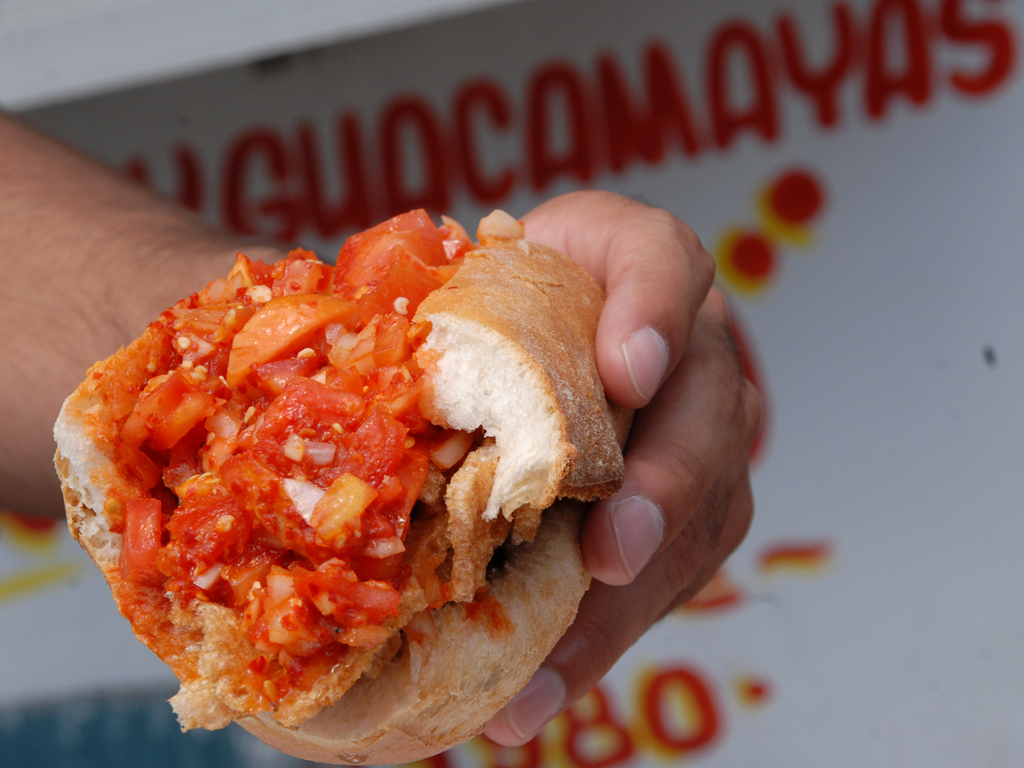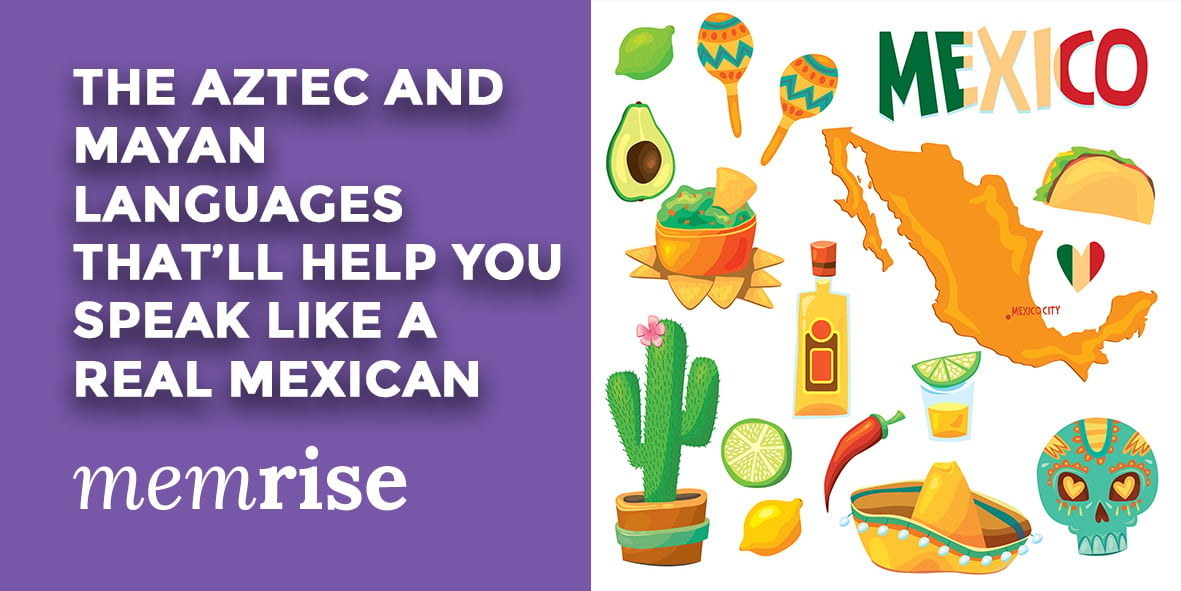Mexico isn’t only about tequila, mariachi music, and chipotle sauce. If that was your idea of Mexico, you’d better keep reading to find out the true sauce of this mythical country.

People often talk about Christopher Columbus ‘discovering’ the Americas, but in reality, when he first arrived in the Caribbean, there were peoples, nations, and empires covering the entire continent right from the Southernmost tip of Chile all the way to the North. Each group of people had their own unique cultures, languages and bustling cities.
Let’s take a look at the influences that the languages of the Aztec and Mayan peoples of Central America have had on Spanish spoken in Mexico.
Nahuatl – language of the Aztec Empire
The largest indigenous language still spoken in Mexico is the language of the Aztecs, Náhuatl, or Nahua, which means “something which sounds clear or pleasant”. This language still has over 1,300,000 native speakers, and has given the world many different words.
xocolātl
Our first Nahuatl word is very well travelled, and is now recognisable over almost the whole world, in Spanish, and English as “chocolate”, in Greek as “σοκολάτα” (sokoláta), and even in Chinese as “巧克力” (qiǎokèlì). There are different theories about the origin of the word, but one of the most likely is that it comes from the Nahuatl words “xococ” meaning “bitter”, and “ātl” meaning “water”. This is because the Aztecs used to use cocoa beans both as a form of currency, but also to make a drink much beloved by Moctezuma II, the Aztec emperor from 1502-1520.
ahuacatl
Another food to have made it around the world from America is the ‘avocado’. You might need to be sitting down for this one. The word ‘avocado’, or in Spanish ‘aguacate’, actually comes from the Nahuatl word ‘ahuacatl’, which means ‘testicle’ due to the fruit’s uncanny resemblance. Good luck looking at avocados the same way in the future!

tomatl / xitomatl
Tomatoes are another food that came from the Americas, and so when the Europeans arrived and didn’t have a word for them, they just took the Nahuatl word “tomatl” (no weird meaning here – it just means ‘tomato’). Interestingly enough though, the Aztecs had the words for two different kinds of tomatoes: “tomatl” for what we call a “tomatillo” in English, and “xitomatl” for other kinds of tomatoes, and in Mexico, many people use the word ‘jitomate’ instead of ‘tomate’ in Spanish.

Photo: Guanajuato Experience
tzictli
‘Chicle’ is a natural tree gum used by the Aztecs and Mayans as a kind of glue, and also to chew, and with it now being one of the main ingredients in chewing gum, most Spanish speakers call chewing gum ‘chicle’.
cacahuatl
Another food-related word that the Spanish language has taken from Nahuatl is the word for a peanut, ‘cacahuate’ in Mexico, and ‘cacahuete’ elsewhere in the Spanish-speaking world. The word ‘cacahuatl’ actually means ‘cocoa bean’, and the Aztecs would usually refer to peanuts by calling them ‘earth cocoa beans’ or ‘tlālcacahuatl’.
papalotl
In Mexico, ‘kites’ – those things you fly on a string – are called ‘papalotes’, which comes from the Nahuatl word for a butterfly, ‘papalotl’.

tiyānquiztli
In Mexico, a flea market is often called a ‘tianguis’ after the Nahuatl word ‘tiyānquiztli’ which has the same meaning. “Tianguis” are embedded in Mexican everyday culture and, contrary to the European conception of a “flea market”, ‘el tianguis’ is a daily market place where you can find anything from the freshest of produce to the realest of quesadillas.

Some other words from Nahuatl often include wildlife native to the region, such as ‘ocelote’ from ‘ōcēlōtl‘ (a big cat similar to a jaguar), ‘coyote’ from ‘coyotl‘, and ‘zopilote’ from ‘zopilotl‘ (a black vulture).
The Mayan Languages
A couple of Mayan words that are widely used Mexican Spanish are:
chel
The Mayan word ‘chel’ means ‘blue’, but in Mexican Spanish, the word ‘chelo’ can be used to describe a person with fair hair and blue eyes, and ‘chela’ means ‘beer’.
ts’onot
In Spanish and in English, a ‘cenote’ is a natural hole in the ground full of water. These were used by the Mayans not only as a source of water, but they also believed that they were gateways to the afterlife and sometimes used them for sacred rituals such as human sacrifice!

Some languages of the Mayan Empire are still spoken in Mexico, mostly in the South-eastern region of Yucatán where you can often hear people speaking with a particular accent with lots of characteristics from the local Yucatec Mayan languages. For example, you might hear someone say “Soy muy peliz en Yucatám” instead of “Soy muy feliz en Yucatán“.
People of Yucatán often use Mayan words and expressions in their daily speech when speaking Spanish, which can often lead to confusion with people even from other parts of Mexico. Here are a few so that you will be prepared!
- purux – fat
- tuch – belly button
- házme loch – give me a hug
- má – no
- dziritz – small
- nojoch – big
- wixar – to pee
- xuun – darling, sweety
- peek’ – dog
- chichí – granny
- chokó – hot
- chihuó – tarantula
- sho – shut up!
 Rob is Memrise‘s English Language Specialist, teaming up with the other language specialists to create language courses that will help you explore the world by unlocking your language superpowers. He also works with Memrise‘s Marketing Team to make fun videos and blog posts to inspire all the language learners out there.
Rob is Memrise‘s English Language Specialist, teaming up with the other language specialists to create language courses that will help you explore the world by unlocking your language superpowers. He also works with Memrise‘s Marketing Team to make fun videos and blog posts to inspire all the language learners out there.
In his spare time, he can usually be found learning languages – currently Hindi & Greek – and exploring the wonders that the London theatre and comedy scenes have in store.











